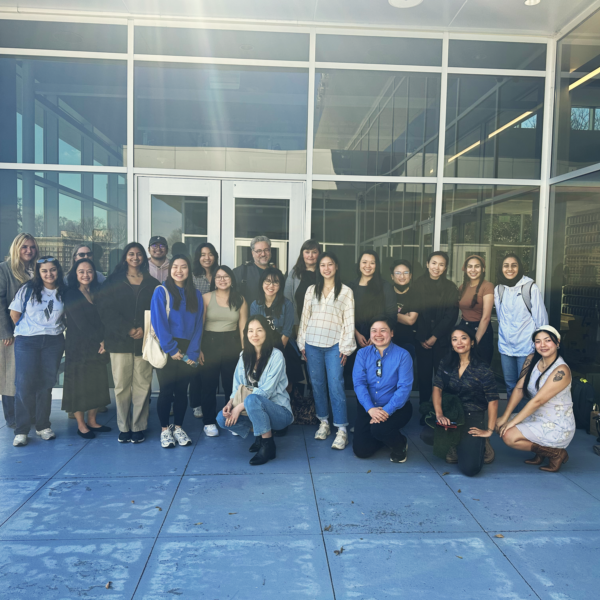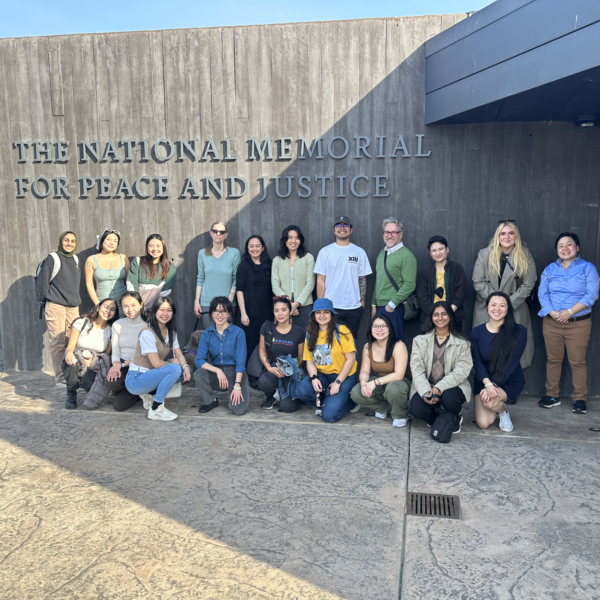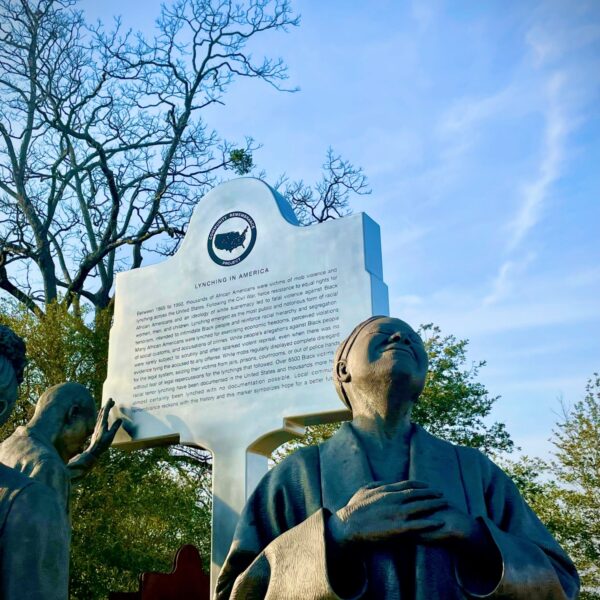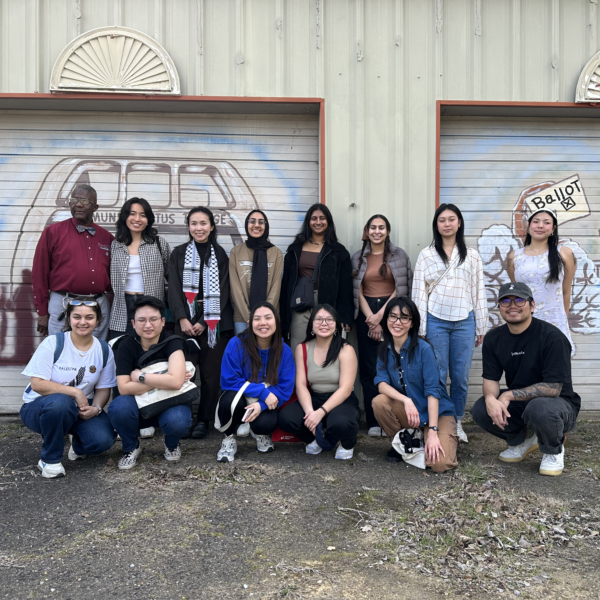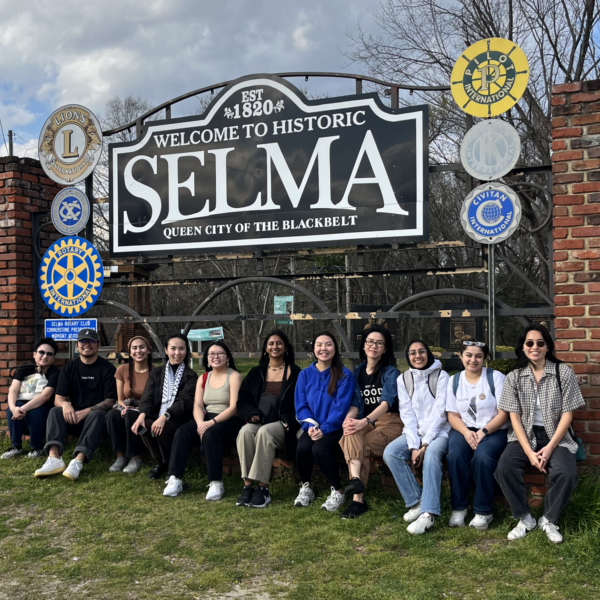At the Asian Law Caucus, our commitment to justice and equity is interwoven with fights for liberation by and for Black, Indigenous, and Latine communities, past and present. Political education plays an important role in deepening our connection across differences and growing our collective power.
As part of that ongoing learning, 21 ALC staff members visited sites of Black-led advocacy and organizing in Montgomery and Selma, Alabama this past February. The two-day trip included visits to the Legacy Museum: From Enslavement to Mass Incarceration, the National Memorial for Peace and Justice, the Edmund Pettus Bridge, the Rosa Parks Museum, and the Freedom Rides Museum, among others.
1/ ALC staff gather around a memorial to Rosa Parks marking the spot where she helped spark the 1955 Montgomery bus boycott.
2/ ALC staff at the Rosa Parks Museum in Montgomery, Alabama. The museum is located next to where she was arrested for boarding a bus and refusing to give up her seat to a white rider.
Each of these sites are immersive experiences that help people engage with a centuries-long history of racial injustice and violence in the U.S. – and the leadership of Black communities to create a world of belonging and freedom. We sought to deepen ALC’s connection to this profound history of resistance. The injustices we seek to dismantle at ALC, from attacks on free speech and voting rights to anti-immigrant laws to unsafe and unaffordable housing, can all trace their roots to how U.S. government has pathologized, surveilled, and discriminated against Black American leaders, workers, and community members.
In the weeks since this trip, staff members have been sharing what they learned, the exhibits and sites that left a lasting mark, and the questions and ideas they are grappling with now. Below, we share some of those reflections.
Legacy Museum & National Memorial in Montgomery
At the Legacy Museum, our team immediately felt a sense of place. The museum is located on the site of a former cotton warehouse where enslaved Black people were forced to labor for decades.
One opening exhibit connected how the movement of chattel slavery from Northern and mid-Atlantic coastal cities to the Deep South was shaped by international and domestic laws around the trafficking and sale of enslaved people.
An ALC staff member observed, “this exhibit illustrated not only the scale of the practice of slavery but also how it is deeply rooted in the foundation and early prosperity of many U.S. cities and towns.”
Sections of the museum highlighted the stories of individuals from different eras to present day. In an exhibit on mass incarceration designed to simulate a prison visiting room, another staff member shared that it still “felt so real to have the person right in front of you telling you about the injustice they are going through.”
1/ An art exhibit featuring the work of Takeisha Jefferson at the Rosa Parks Museum.
2/ ALC staff take a picture with Equal Justice Initiative attorney Tatiana Bertsch after a presentation on the Initiative’s legal and cultural work and its position in Montgomery.
As we walked through the museum halls, we also reckoned with the unspeakable emotional and psychological toll of family separation. After the Civil War, many newly freed enslaved people put notices in newspapers asking for any information on the whereabouts or status of their children, parents, or spouse. Many had not seen their family members in years after being sold to a different owner of enslaved people and were no longer sure of their loved ones’ current names.
We drew parallels to our work defending the rights of immigrants and refugees incarcerated in inhumane ICE detention centers as well as our advocacy to reunite loved ones who are ripped apart by our immigration laws. For centuries, starting in 1619, family separation has been a tool to exert power over people. The systems we live with today are continuation of what started during chattel slavery.
Weeks later, we’re continuing to talk about how our work today and our history as the first civil rights organization serving low-income Asian Americans sit within the legacy of slavery, Jim Crow, and Black activism.
For years, volunteers have collected dirt from lynching sites across the U.S. That dirt now sits in illuminated glass jars at the Legacy Museum. The Tuskegee Institute has recorded the lynchings of 3,446 Black Americans between 1882 and 1968, some whose names we saw at the National Memorial for Peace and Justice. Racial terror lynchings were typically carried out by a mob and a permissive local government.
One staff member reflected, “My own family fled a different kind of violence and I am still putting together the pieces of my family’s life before and after the war in Southeast Asia. It’s difficult to think about the racial terror that Black Americans survived, their humanity and status determined and violently reinforced by all levels of government and people.”
“The National Memorial for Peace and Justice was incredibly eye opening. Seeing the names of real people who were lynched and the way the site was designed had an incredibly powerful affect that brought many of us to tears.” – ALC staff member
1/ Metal blocks commemorating the names of lynching victims hang in rows throughout the National Memorial for Peace and Justice.
2/ ALC staff before entering the National Memorial for Peace and Justice.
3/ Artist Branly Cadet's sculpture "Arise," memorializes the activists and leaders working to advance the community's remembrance of the historical lynchings.
Edmund Pettus Bridge in Selma
While some ALC staff went to the Rosa Parks Museum and Freedom Rides Museum in Montgomery, others traveled to Selma for a day. We started at the Lowndes Interpretive Center, then toured the National Voting Rights Museum, and ended with a walk across the Edmund Pettus Bridge.
Our tour guide, Mr. Jake Williams, was raised in rural Lowndes County at the height of the Civil Rights Movement. As a child, he joined the 1965 voting rights march from Selma to Montgomery. With Mr. Williams, we traced the steps of the marchers from Selma to Montgomery.
Mr. Williams teaches history that is often missing from our textbooks, including the severe costs and dangers endured by people who offered aid or campgrounds to the marchers. He shared how gentrification and displacement in Montgomery, Selma, and Lowndes County are affecting the lives of Black residents today - and the local activism that continues for racial justice.
As we walked across the Edmund Pettus Bridge, we thought about our own work fighting evictions in San Francisco and helping Californians who use non-English languages register to vote and cast their ballots, especially as we learn of increasing racial disparities in voter turnout in recent years. Just days after this trip, ALC’s voting rights team organized our state’s largest nonpartisan election protection program for the March primary election. ALC’s voting rights and democracy work is directly connected to the federal Voting Rights Act of 1965, which was passed months after the Selma Marches. In other words, our work and progress would not be possible but for the sacrifices and courage of the Selma marchers, including those that experienced “Bloody Sunday,” when state troopers violently beat protestors as they attempted to cross the bridge.
In Selma, ALC staff walked across the Edmund Pettus Bridge and toured the National Voting Rights Museum and Institute.
Reflection, Discussions, and Takeaways
We came back from the trip feeling differently about our work.
In the New York Times Magazine just last week, Nikole Hannah-Jones wrote a deeply-reported essay on the Supreme Court decision on affirmative action marking “the culmination of a radical 50-year strategy.” She argues that “to meet the moment, our society must forcefully recommit to racial justice by taking lessons from the past…Diversity matters in a diverse society, and American democracy by definition must push for the inclusion of all marginalized people. But remedies for injustice also need to be specific to the harm.”
What does forcefully recommitting to racial justice look like for ALC? How do we honestly navigate and advance conversations about identity, even as anti-democratic forces are intentionally seeking Asian American faces to sow division and dismantle hard-won rights?
Recently, ALC joined the Alliance for Reparations, Reconciliation, and Truth, led by the California Black Power Network, Equal Justice Society, and six former members of the California Reparations Task Force. We’ll be working alongside Black-led and non-Black ally organizations to help more people learn about the Reparations Task Force’s historic report last year and take action to address the harms of slavery, Jim Crow, and ensuing decades of discrimination targeting Black Californians. As this work progresses, we see it as another chance to apply what we learned in Alabama and our replenished resolve to fight for collective justice.

Maya Angelou's words echo outside the Legacy Museum in Montgomery, Alabama.



